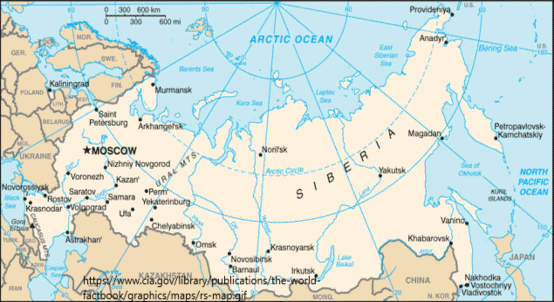Map10.1-Russia

1.1. Russia: Background

♤ Russia stretches over a vast expanse of eastern Europe and northern Asia. Once the preeminent republic of the Union of Soviet Socialist Republics (U.S.S.R. commonly known as the Soviet Union), Russia became an independent country after the dissolution of the Soviet Union in December 1991.
♤ It is world’s largest country, it covers nearly twice the territory of Canada, the second largest. It extends across the whole of northern Asia and the eastern third of Europe, spanning 11 time zones and incorporating a great range of environments and landforms, from deserts to semiarid steppes to deep forests and Arctic tundra. Russia contains Europe’s longest river, the Volga, and its largest lake, Ladoga. Russia also is home to the world’s deepest lake, Baikal, and the country recorded the world’s lowest temperature outside the North and South poles.
♤ The inhabitants of Russia are quite diverse. Most are ethnic Russians, but there also are more than 120 other ethnic groups present, speaking many languages and following disparate religious and cultural traditions.
♤ Most of the Russian population is concentrated in the European portion of the country, especially in the fertile region surrounding Moscow, the capital.
♤ Moscow and St. Petersburg (formerly Leningrad) are the two most important cultural and financial centres in Russia. Russians are also populous in Asia, however; beginning in the 17th century, and particularly pronounced throughout much of the 20th century, a steady flow of ethnic Russians and Russian-speaking people moved eastward into Siberia, where cities such as Vladivostok and Irkutsk now flourish.
1.1.1. Russia: Borders and Resources
♤ Russia is bounded to the north and east by the Arctic and Pacific oceans, and it has small frontages in the northwest on the Baltic Sea at St. Petersburg and at the detached Russian oblast (region) of Kaliningrad (a part of what was once East Prussia annexed in
1945), which also abuts Poland and Lithuania. To the south Russia borders North Korea, China, Mongolia, and Kazhakstan, Azerbaijan and Georgia. To the south west and west it borders Ukraine, Belarus, Latvia, and Estonia, as well as Finland and Norway.
♤ Although the climate adds a layer of difficulty to daily life, the land is a generous source of crops and materials, including vast reserves of oil, gas, and precious metals.
♤ Russia is among the world’s leading producers of oil, extracting about one-fifth of the global total. It also is responsible for more than one-fourth of the world’s total natural gas output.
